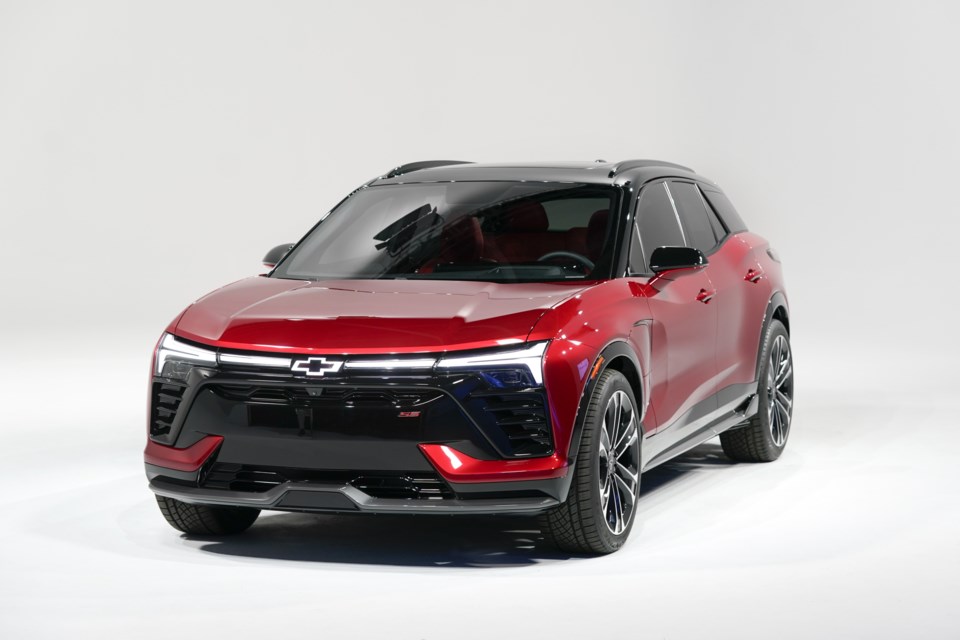WARREN, Mich. (AP) — In their first rollouts of electric vehicles, America's automakers targeted people who value short-range economy cars. Then came EVs for luxury buyers and drivers of pickups and delivery vans.
Now, the companies are zeroing in at the heart of the U.S. auto market: The compact SUV. In their drive to have EVs dominate vehicle sales in coming years, the automakers are promoting their new models as having the range, price and features to rival their gas-powered competitors.
Some are so far proving quite popular. Ford’s $45,000-plus Mustang Mach E is sold out for the model year. On Monday night, General Motors’ Chevrolet brand introduced an electric version of its Blazer, also starting around $45,000, when it goes on sale next summer.
Also coming next year: An electric Chevy Equinox, with a base price of about $30,000, whose price could give it particular appeal with modest-income households. There’s also the Hyundai Ioniq 5 and Volkswagen’s ID.4 in the $40,000s and Nissan’s upcoming Ariya around $47,000 with a lower-priced version coming.
All start off considerably less expensive than Tesla’s Model Y small SUV, the current top EV seller, with a starting price well into the $60,000s.
The new models, which can get about 300 miles per electric charge, are aimed at the largest segment of the U.S. market: Modest-size SUVs, representing about 20% of new-vehicle sales. Industry experts say entering the smaller SUV segment, with its reach into a broader demographic of buyers, is sure to boost electric vehicle sales nationally.
“Going to the smaller utility segment gives you the opportunity to access the most customers in one (market) segment,” said Stephanie Brinley, principal analyst for S&P Global Mobility. “To make a transition from (internal combustion engines) to electric, you have to be in more space. You have to be in more price points. You have to be in more sizes.”
Brinley noted that the small and midsize SUV segments meet many people’s needs, something that previous electric vehicles did not.
“If it’s a price you can reach but it’s a product that you can’t put your kids and your dog in, you’re not going to buy it,” she said.
Chevrolet says the Blazer will get a minimum of 247 miles (398 kilometers) per charge. Pricier high-end versions could go up to 320 miles (515 kilometers). The Blazer will be available with Chevrolet’s SS performance package with a zero-to-60 mph (97 kilometers per hour) time of under four seconds. There will be a police version, too.
“Early on, the demographic composition of an EV buyer was certainly someone that perhaps had higher education, higher household income,” said Steve Majoros, Chevrolet's marketing director. “That’s very indicative of early adopters. But as we move up that curve, the intention and where we’re pricing this product is to certainly make it more available for more mainstream buyers.”
To attract buyers of modest means, , in the $30,000-to-$35,000 range, GM CEO Mary Barra . Electric vehicles, she said, also have to have the range and charging network so they can be the sole vehicle that some people own.
“Most electric vehicle owners today own multiple vehicles, so they have an internal combustion vehicle to jump into depending on their needs,” .
Automakers have been pushing to fully restore a $7,500 tax credit for people who buy EVs to jump-start sales. But the measure is stalled in Congress. It’s especially important for GM, Tesla and Toyota, which have maxxed out the number of credits they are allowed and can no longer offer them to buyers. Other automakers are approaching the limit, too.
Money for the credits, as well as funding for additional EV charging stations, was in President Joe Biden’s $1.8 trillion “Build Back Better” social and environment bill, which is all but dead because of the objections of Sen. Joe Manchin, a West Virginia Democrat.
Last week, that included provisions to combat climate change. He indicated his support for just two items from Biden’s broader agenda: Reducing prescription drug costs and bolstering subsidies for families to buy health insurance. His vote in an evenly split Senate would be needed for anything to pass.
Even without the tax credit, the industry’s march toward electric vehicles is moving apace. Edmunds.com says electric vehicles now account for about 5% of U.S. new vehicle sales with 46 models on sale. S&P’s Brinley foresees the market share rising to 8% next year, 15% by 2025 and 37% by 2030.
“It seems like the number of choices are growing exponentially for electric vehicles as we move forward,” said Erich Merkle, Ford’s top U.S. sales analyst.
Demand for battery-powered vehicles and gas-electric hybrids has grown as gasoline prices skyrocketed this year. Dealers report that every vehicle delivered is typically already sold or gone soon after it arrives.
Jonathan Chariff, CEO of South Motors, an 11-dealer group in South Florida, said it’s impossible to assess just how big the demand for electric vehicles is. There’s huge interest, especially in electric SUVs, and vehicles are selling fast. But the supply is constrained because automakers don’t have enough computer chips to build as many vehicles as they want.
Given the enormous consumer interest in EVs, Chariff said he expects the vehicles to continue to sell even if their prices don’t fall.
“The real question," he said, "is if and when the supply chain can meet the market demand, what is the true price point?”
Tom Krisher, The Associated Press




